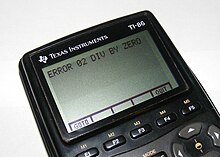শূন্যৰে হৰণ

গণিতত শূন্যৰে হৰণৰ অৰ্থ হ'ল এনে বিভাজন য'ত বিভাজক ০। এনে হৰণক ক/০ বুলি লিখিব পাৰি। সাধাৰণ পাটীগণিতত ক/খ=গৰ অৰ্থ হ'ল, গ*খ=ক। পিচে ক/০=গ হ'লে, ক=গ*০ হ'ব লাগিব, যাৰ অৰ্থ হ'লে, ক=০ হ'ব লাগিব। সেয়েহে 'ক'ৰ ঠাইত যদি ০ৰ বাহিৰে আন, শূন্যতকৈ বেলেগ মূল্য থকা সংখ্যা প্ৰয়োগ কৰা হয়, উত্তৰ, গ বা ক/০ অসংজ্ঞাকৃত বুলি কোৱা হয়। যদি ক=০, তথাপিও গ বা ক/০ অসংজ্ঞাকৃত কাৰণ, যিহেতু যিকোনো সংখ্যাক ০ৰে পূৰণ কৰিলে উত্তৰত ০ই লাভ কৰা হয়, গৰ মূল্য যিকোনো সংখ্যা হ'ব পাৰে। উদাহৰণ স্বৰূপে, ০*০=০, সেয়ে গ=০ হ'ব পাৰে, ০*৩=০, সেয়ে গ=৩ও হ'ব পাৰে ইত্যাদি।
ৰাইমান গোলক, ৰিয়েল প্ৰজেক্টিভ লাইন আদিত ক/০ক সংজ্ঞা প্ৰদান কৰা হৈছে, কিন্তু তেনে প্ৰচেষ্টাই পাটীগণিতৰ আটাইতকৈ সৰল নিয়মকো সন্তুষ্ট কৰিব নোৱাৰে।
ক/০ যে অসংজ্ঞাকৃত, এই কথা সৰ্বপ্ৰথম জৰ্জ বাৰ্কলিৰ দা এনেলিষ্টত প্ৰকাশ পাইছিল।
গণক যন্ত্ৰৰ কোনো প্ৰ'গ্ৰামত শূন্যৰে বিভাজনৰ বাবে বৃহৎ ভুলৰ সৃষ্টি হ'ব পাৰে। উত্তৰত + বা - অসীম, ত্ৰুতি বাৰ্তা, অসাংখ্যিক মূল্য পাব পৰা যায়, প্ৰগ্ৰামিং এনভাইৰন্মেণ্টৰ ওপৰত নিৰ্ভৰ কৰি। প্ৰ'গ্ৰামৰ চলন বন্ধও হ'ব পাৰে।


প্ৰাৰম্ভিক পাটীগণিতত
[সম্পাদনা কৰক]সাধাৰণ ভাষাত, 'হৰণ' বা 'বিভাজন'ৰ অৰ্থ হ'ল 'সমানভাৱে ভগাই দিয়া'। উদাহৰণ স্বৰূপে, এখন মেজত দহটা পিঠা আছে। সেই পিঠা কেইটাক পাঁচটা শিশুৰ মাজত সমানে ভগাই দিলে, প্ৰতিটোৰে ভাগত দুটাকৈ পৰিব। অৰ্থাৎ ১০/৫=২। পিচে ১০/০ৰ মূল্য জানিব পৰা নাযায়। ১০টা পিঠা '০'টা শিশুৰ মাজত ভগাব পৰা নাযায়। যদি কোনো শিশুৱেই নাই, ভগাব কাৰ মাজত?
আন এক দিশৰ পৰা চাব পৰা যায়। ভাজ্য=ভাজকxহৰণফল। যদি ক/০=খ হয়, তেন্তে ০খ=ক হোৱাটো অনিবাৰ্য। অৰ্থাৎ ক=০ হ'বই লাগিব। অন্যথা সম্ভৱ নহয়। আকৌ, যদি ক=০, তেতিয়া খৰ মূল্য যিকোনো সংখ্যাৰ সমান হ'ব পাৰে, কাৰণ সকলো সংখ্যাকেই ০ৰে পূৰণ কৰিলে ০ই লাভ কৰা যায়।
প্ৰাৰম্ভিক প্ৰচেষ্টা
[সম্পাদনা কৰক]শূন্যক এটি সংখ্যাৰ ৰূপত সৰ্বপ্ৰথম ব্ৰহ্মসুপ্তৰ (৫৯৮-৬৬৮) ব্ৰহ্মস্ফুতসিদ্ধান্তত ব্যৱহাৰ কৰা হৈছিল। তেওঁ শূন্যৰ গুণাগুণ সংজ্ঞায়িত কৰিবলৈও চেষ্টা কৰিছিল। পিচে, তেওঁৰ এই প্ৰয়াস সফল নহ'ল। তেওঁৰ মতে,
এটি ধনাত্মক বা ঋণাত্মক সংখ্যাক যেতিয়া শূন্যৰে বিভাজিত কৰা য়, উত্তৰত এটি ভগ্নাংশ পোৱা যায় যাৰ হৰ শূন্য। শূন্যক এটি ধনাত্মক বা ঋণাত্মক সংখ্যাৰে বিভাজিত কৰিলে শূন্য, বা শূণ্য লৱৰ ৰূপত আৰু সসীম সংখ্যাটো হৰৰ ৰূপত থকা এটি ভগ্নাংশ পোৱা যায়। শূন্যক শূন্যৰে হৰণ কৰিলে শূন্য পোৱা যায়।
৮৩০ত মহাবীৰে ব্ৰহ্মগুপ্তৰ কথন শুদ্ধ কৰাৰ বিফল প্ৰচেষ্টাত লিখিলে যে "শূন্যৰে এটি সংখ্যা বিভাজন কৰিলে সংখ্যাটো সলনি নহয়।"[1]
বীজগণিতত
[সম্পাদনা কৰক]পূৰণৰ প্ৰতিলোম হৰণ
[সম্পাদনা কৰক]হেত্বাভাস
[সম্পাদনা কৰক]কলন গণিতত
[সম্পাদনা কৰক]প্ৰসাৰিত বাস্তৱ ৰেখাত
[সম্পাদনা কৰক]প্ৰক্ষিপ্তভাৱে প্ৰসাৰিত বাস্তৱ ৰেখাত
[সম্পাদনা কৰক]ৰাইমান গোলকত
[সম্পাদনা কৰক]প্ৰসাৰিত অ-ঋণাত্মক বাস্তৱ ৰেখাত
[সম্পাদনা কৰক]গণক যান্ত্ৰিক পাটীগণিতত
[সম্পাদনা কৰক]টোকা
[সম্পাদনা কৰক]- ^ Cajori, Florian, "Absurdities due to division by zero: An historical note", The Mathematics Teacher: 366–368, JSTOR 27951153.
- ^ Kaplan, Robert (1999). The Nothing That Is: A Natural History of Zero. New York: Oxford University Press. pp. 68–75. ISBN 0-19-514237-3.
- Cody, W.J. (March 1981). "Analysis of Proposals for the Floating-Point Standard". Computer 14 (3): 65. doi:10.1109/C-M.1981.220379. Retrieved 11 September 2012. "With appropriate care to be certain that the algebraic signs are not determined by rounding error, the affine mode preserves order relations while fixing up overflow. Thus, for example, the reciprocal of a negative number which underflows is still negative."
- "Sunk by Windows NT". Wired News. 1998-07-24.
- William Kahan (14 October 2011). "Desperately Needed Remedies for the Undebuggability of Large Floating-Point Computations in Science and Engineering" (PDF).
উৎস
[সম্পাদনা কৰক]- Patrick Suppes 1957 (1999 Dover edition), Introduction to Logic, Dover Publications, Inc., Mineola, New York. ISBN 0-486-40687-3 (pbk.). This book is in print and readily available. Suppes's §8.5 The Problem of Division by Zero begins this way: "That everything is not for the best in this best of all possible worlds, even in mathematics, is well illustrated by the vexing problem of defining the operation of division in the elementary theory of arithmetic" (p. 163). In his §8.7 Five Approaches to Division by Zero he remarks that "...there is no uniformly satisfactory solution" (p. 166)
- Charles Seife 2000, Zero: The Biography of a Dangerous Idea, Penguin Books, NY, ISBN 0-14-029647-6 (pbk.). This award-winning book is very accessible. Along with the fascinating history of (for some) an abhorrent notion and others a cultural asset, describes how zero is misapplied with respect to multiplication and division.
- Alfred Tarski 1941 (1995 Dover edition), Introduction to Logic and to the Methodology of Deductive Sciences, Dover Publications, Inc., Mineola, New York. ISBN 0-486-28462-X (pbk.). Tarski's §53 Definitions whose definiendum contains the identity sign discusses how mistakes are made (at least with respect to zero). He ends his chapter "(A discussion of this rather difficult problem [exactly one number satisfying a definiens] will be omitted here.*)" (p. 183). The * points to Exercise #24 (p. 189) wherein he asks for a proof of the following: "In section 53, the definition of the number '0' was stated by way of an example. To be certain this definition does not lead to a contradiction, it should be preceded by the following theorem: There exists exactly one number x such that, for any number y, one has: y + x = y"
- ↑ Kaplan, Robert (1999). The Nothing That Is: A Natural History of Zero. New York: Oxford University Press. pp. 68–75. ISBN 0-19-514237-3.
